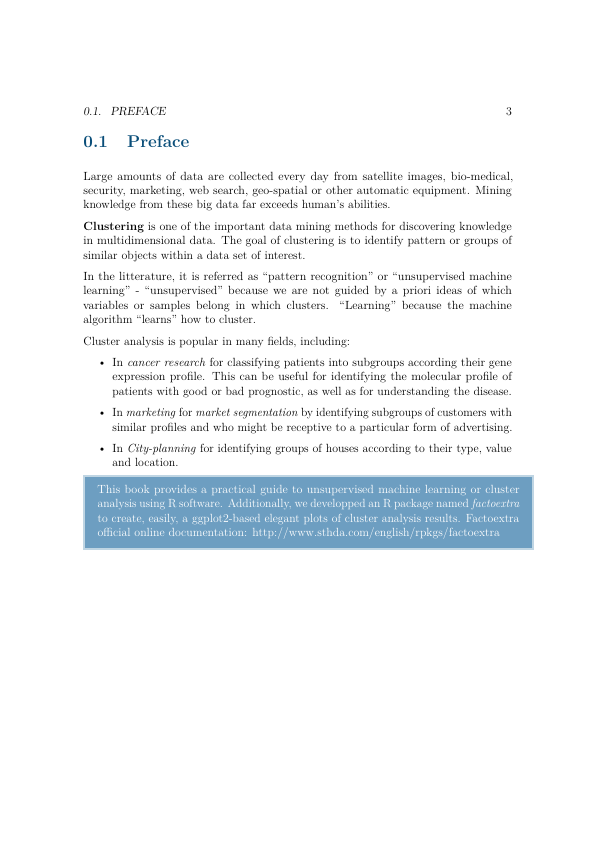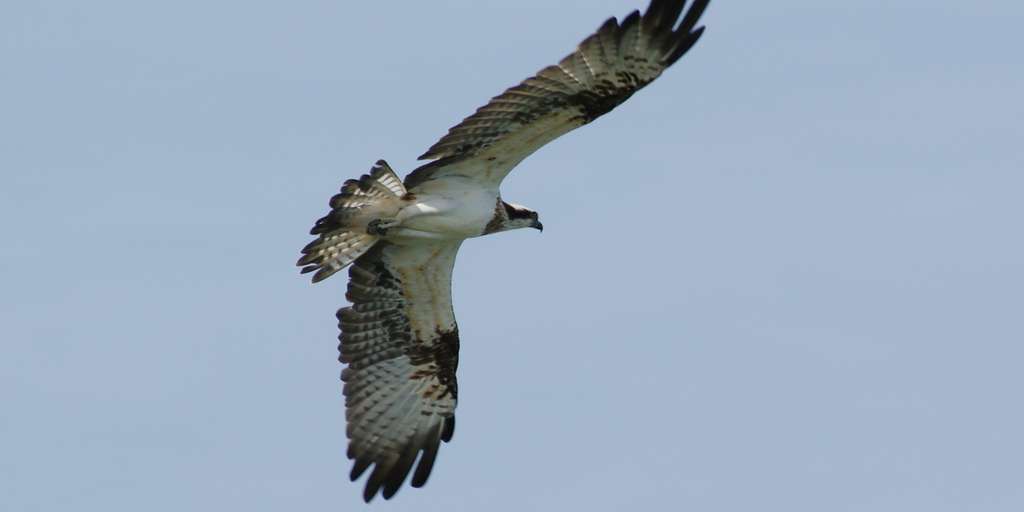This article describes how to extract text from PDF in R using the pdftools package.
Contents:
Installation
For MAC OSX and Windows, you can use the following code to install directly from CRAN repository:
install.packages("pdftools")For Linux/Unix systems, you may need to first install the poppler library on your computer. Use the following bash code depending on your operating system:
- On Debian/Ubuntu:
sudo apt-get install libpoppler-cpp-dev - On Fedora or CentOS:
sudo yum install poppler-cpp-devel - On Mac OSX :
brew install poppler
Load the package
library("pdftools")Extract the PDF text content
# Download a demo pdf file
pdf.file <- "https://www.datanovia.com/en/https://www.datanovia.com/en/wp-content/uploads/dn-tutorials/book-preview/clustering_en_preview.pdf"
download.file(pdf.file, destfile = "clustering.pdf", mode = "wb")# Extract the text for all pages
pdf.text <- pdf_text("clustering.pdf")
# Display the third page text
cat(pdf.text[[3]])## 0.1. PREFACE 3
## 0.1 Preface
## Large amounts of data are collected every day from satellite images, bio-medical,
## security, marketing, web search, geo-spatial or other automatic equipment. Mining
## knowledge from these big data far exceeds human’s abilities.
## Clustering is one of the important data mining methods for discovering knowledge
## in multidimensional data. The goal of clustering is to identify pattern or groups of
## similar objects within a data set of interest.
## In the litterature, it is referred as “pattern recognition” or “unsupervised machine
## learning” - “unsupervised” because we are not guided by a priori ideas of which
## variables or samples belong in which clusters. “Learning” because the machine
## algorithm “learns” how to cluster.
## Cluster analysis is popular in many fields, including:
## • In cancer research for classifying patients into subgroups according their gene
## expression profile. This can be useful for identifying the molecular profile of
## patients with good or bad prognostic, as well as for understanding the disease.
## • In marketing for market segmentation by identifying subgroups of customers with
## similar profiles and who might be receptive to a particular form of advertising.
## • In City-planning for identifying groups of houses according to their type, value
## and location.
## This book provides a practical guide to unsupervised machine learning or cluster
## analysis using R software. Additionally, we developped an R package named factoextra
## to create, easily, a ggplot2-based elegant plots of cluster analysis results. Factoextra
## official online documentation: http://www.sthda.com/english/rpkgs/factoextraRender the pdf pages as images
# Renders pdf to bitmap array
bitmap <- pdf_render_page("clustering.pdf", page = 3)
# Save bitmap image
png::writePNG(bitmap, "images/clustering-page-3.png")
jpeg::writeJPEG(bitmap, "images/clustering-page.jpeg")
webp::write_webp(bitmap, "images/clustering-page.webp")
Summary
This articles describes how to extract text from a PDF file and to render the pdf pages as images.
Recommended for you
This section contains best data science and self-development resources to help you on your path.
Books - Data Science
Our Books
- Practical Guide to Cluster Analysis in R by A. Kassambara (Datanovia)
- Practical Guide To Principal Component Methods in R by A. Kassambara (Datanovia)
- Machine Learning Essentials: Practical Guide in R by A. Kassambara (Datanovia)
- R Graphics Essentials for Great Data Visualization by A. Kassambara (Datanovia)
- GGPlot2 Essentials for Great Data Visualization in R by A. Kassambara (Datanovia)
- Network Analysis and Visualization in R by A. Kassambara (Datanovia)
- Practical Statistics in R for Comparing Groups: Numerical Variables by A. Kassambara (Datanovia)
- Inter-Rater Reliability Essentials: Practical Guide in R by A. Kassambara (Datanovia)
Others
- R for Data Science: Import, Tidy, Transform, Visualize, and Model Data by Hadley Wickham & Garrett Grolemund
- Hands-On Machine Learning with Scikit-Learn, Keras, and TensorFlow: Concepts, Tools, and Techniques to Build Intelligent Systems by Aurelien Géron
- Practical Statistics for Data Scientists: 50 Essential Concepts by Peter Bruce & Andrew Bruce
- Hands-On Programming with R: Write Your Own Functions And Simulations by Garrett Grolemund & Hadley Wickham
- An Introduction to Statistical Learning: with Applications in R by Gareth James et al.
- Deep Learning with R by François Chollet & J.J. Allaire
- Deep Learning with Python by François Chollet







Is it possible to extract text from just a specific area on the pdf? For example, just pulling the text from the blue area of the page in the example. I’m working on a project where I only want to extract the text from a specific colored area on the page.